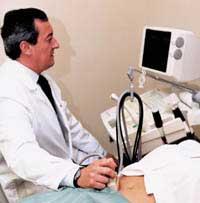You don't hear ultrasound but ...
Dogs and bats, for example, are able to hear ultrasound, but man has nothing. However, man has learned to take advantage of those sounds that cannot be heard.

Ultrasound has long been known. These are sounds of more than 20,000 hertz, so the human ear cannot perceive them. The behavior of ultrasound is similar to that of conventional sounds: they use a means to travel - air, human tissues -, move at a certain speed, have wavy shape and transport energy.
There are many applications of this type of sounds. Ultrasounds are able to pass through numerous materials. Depending on the structure and composition of the material, the behavior of ultrasound varies. One of the best known uses is the study of biological tissues. In this case, the ultrasound generator -transducer - is used as sonar, directing the waves to the patient. Logically, the waves are then reflected, but this reflection depends on the type of tissues that the waves find along the way. The analysis of the reflected waves allows to obtain images of the inside of the organism. Therefore, the use of ultrasound allows the medicine to obtain a lot of information.
Ultrasounds, for example, are based on this principle, so they provide the right images of fetuses and soft organs. By losing intensity the reflex that ultrasound can produce as they enter and expand, they lose effectiveness. Logically, to increase efficiency, it would be possible to increase the energy of ultrasound, but it is worked within a limit, since otherwise ultrasound can cause adverse effects on the patient.
In some cases it may be interesting to use different frequency ultrasound. Due to the energy of sound, by vibrating tissue molecules, this process produces heat and mechanical energy. Thus, depending on the frequency of application, ultrasound can be used to perform diagnostics, pain mitigation, tissue repair and tissue destruction.
In therapeutic ultrasound devices, a high-frequency generator generates electrical current. Electricity reaches the transducer via a cable. The glass on the transducer head, depending on the electricity it receives, can expand or contract, producing wave sounds of different shapes.

Ultrasound can be used directly on the skin or by other means, such as water. In the first case a gelatin substance is used to make bridge. Otherwise, the skin may reflect energy. In the second case, containers filled with water are used. In this case, ultrasounds focus precisely, without touching the body, and may have another use, such as kidney stone puncture.
These high-frequency sounds have a double effect on biological tissues: on the one hand, there is a thermal mechanism -heat - result of the energy that absorbs the wave, and on the other, a cavitation mechanism, which raises the pressure and temperature of gases or liquids that may be present in cavities, that is, resonances.
These are not the only therapeutic uses that ultrasound has. For a few years they have also been used in aesthetic matters. Apart from health, they have other applications. Bats use them to make the "maps" of the area - the brain makes an interpretation of the reflection of the waves and places the obstacles they can find in the way, while engineers seek possible cracks within the metal structures.
Being able to access the inside of the materials and get a lot of information about it, in many sectors ultrasound is a very useful technological tool. They will not be heard, they will not make much noise, but obviously ultrasounds have more and more influence in everyday life.
Published in 7
Buletina
Bidali zure helbide elektronikoa eta jaso asteroko buletina zure sarrera-ontzian











